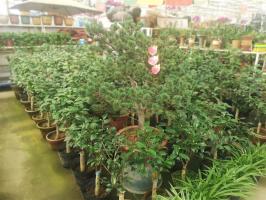How to apply epsom salt to potted plants
Epsom salt, also known as magnesium sulfate, is a popular supplement used in gardening to improve plant growth, development, and overall health. It has been used for centuries because of its proven benefits. If you want to apply epsom salt to your potted plants, it is essential to know how to do it properly for maximum benefits.
1. Determine the right amount of epsom salt to use
Before adding any supplement to your plants, it's essential to determine the right amount to use. Too much or too little epsom salt can harm your plants. Typically, the recommended dose is one tablespoon of epsom salt per gallon of water. However, it would be best if you researched your plant's specific requirements to determine the appropriate amount to use.
2. Mix epsom salt with water
To apply epsom salt to your potted plants, you need to dissolve the salt in water to make it easy for your plants to absorb. You should dissolve the salt thoroughly in lukewarm water before applying it to the soil. Stir the mixture constantly until the epsom salt has dissolved completely. Furthermore, it would help if you did not use cold water when preparing the epsom salt mixture, as it takes longer to dissolve in cold water.
3. Apply epsom salt to the soil
Once you have prepared your epsom salt mixture, it's time to apply it to your potted plants. First, water your plants thoroughly before applying the epsom salt solution. This will help the soil to absorb the solution more easily. Then, pour the epsom salt mixture directly to the soil without getting it on the plants' leaves. You can also use a spray bottle to apply the solution to the leaves and stems. Be sure to apply the solution evenly to cover the entire soil surface in the pot.
4. Monitor your plants after application
After applying epsom salt to your potted plants, it's crucial to monitor them for a few days to observe how they respond. Observe the plants for any signs of distress, such as yellowing leaves, wilting, or burning. If you notice any signs of distress, stop applying epsom salt immediately and flush the soil with water. Flushing will help to remove salt buildup and decrease the risk of salt damage to your plants.
5. Apply epsom salt regularly
Once you have observed your plant's response to epsom salt, you can apply it regularly to help improve their overall health. However, it would help if you did not overdo it. Over-using epsom salt can harm your plants. Plan to apply epsom salt to your potted plants once every month or two, depending on the plant's specific requirements.
Conclusion
Epsom salt is an excellent natural supplement for potted plants, providing essential nutrients, promoting growth, and encouraging overall health. If you want to apply epsom salt to your potted plants, follow the steps outlined above for the best results. Remember to monitor your plants for any signs of distress and adjust the amount and frequency of epsom salt application accordingly. With proper application, you can enjoy the many benefits of epsom salt for your potted plants.

 how many times do yo...
how many times do yo... how many planted tre...
how many planted tre... how many pine trees ...
how many pine trees ... how many pecan trees...
how many pecan trees... how many plants comp...
how many plants comp... how many plants can ...
how many plants can ... how many plants and ...
how many plants and ... how many pepper plan...
how many pepper plan...
































